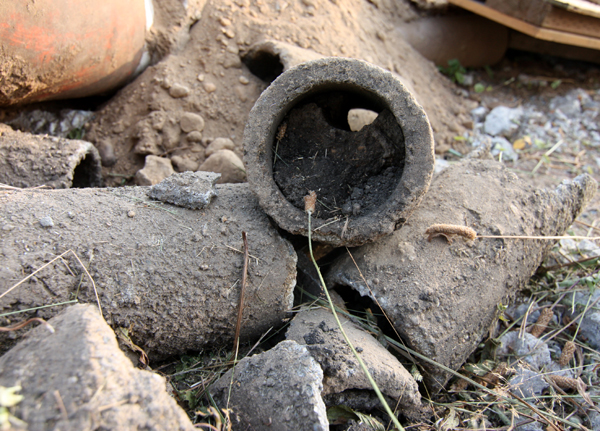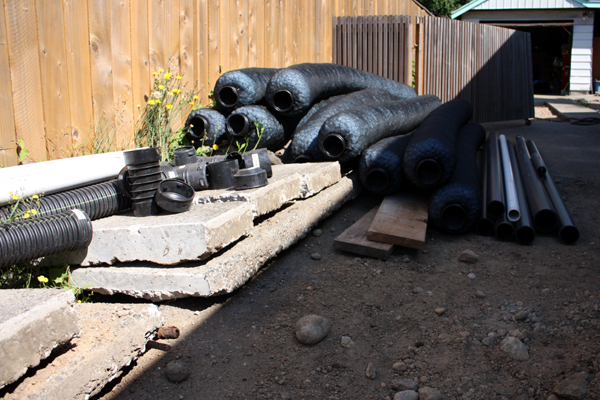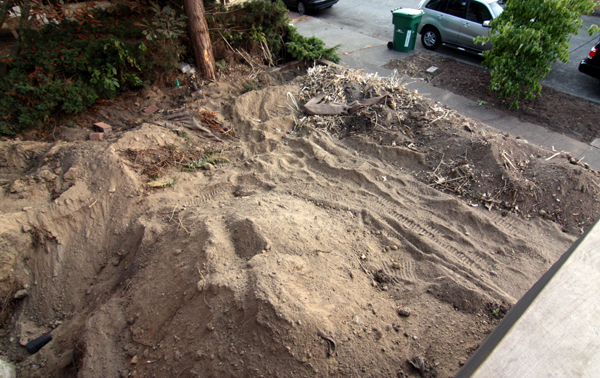Bobcat weekend, take 2.
Two weekends ago we dug out around our basement foundation to prep for new drains. A hose leak in the bobcat slowed our progress, but this weekend we were back at it, faster and stronger. Digging out around the basement was the first step, the second was to dig two trenches on each side of the front yard that go from the corner of the foundation wall out to the retaining wall (about 20′ each). During heavy rains, this gives excess water a place to flow (and then infiltrate) that is away from the house.
Well hello there pickaxe. Haven’t seen you since we dug out the crawl space.
Once again, we hit hardpan about 3′ deep in some spots and Kyle had to use the pickaxe to break up the soil till we reached the desired depth. Not as confident swinging an axe, I used the smaller trenching shovel to break up hardpan on the other side of the house. The practice conjured up fond memories of elementary school, when my friends and I earnestly spent our recess unearthing “dinosaur bones” on the playground. I only wish this was as gratifying.
For the trench on the north side of the front yard, we’ll tight line the drain for the first 10′ (which basically means the pipe won’t have any holes in it). The second 10′ will be a perforated system that allows water to disperse out and infiltrate back into the soil.
Of course, we’re relying on gravity for the water to flow properly so we used a laser level to measure the vertical distance at various points to ensure that we had enough of a positive slope (about 1/4″ to 1/2″ per foot).
While excavating, we found some old clay pipe sections that were at one point connected to the roof downspouts. Huh, wonder why they weren’t working?
[What we didn’t find – gold bars. I think I’ve officially given up on finding a buried treasure at this house. It would be nice though – “Couple Finds Gold Bars and Uses them to Pay for Remodel”.]
A traditional drain assembly would include a perforated plastic pipe that is surrounded with drain rock and then wrapped in filter fabric to prevent the drain from getting clogged with roots. To save time, we found a pre-assembled product called, no kidding, EZ Flow. The price was really reasonable too (about $3/linear foot). Instead of drain rock, the product uses a lightweight aggregate so the pieces are relatively easy to carry.
The smaller black flexible pipe will connect to the drains around the house and then direct excess water to the perforated assembly near the retaining wall. The two pieces are both 4″ in diameter and connected with a standard coupling fitting.
Just drop it in and you’re done. Easy. We like that.
The first weekend we hauled away about 8 yards of dirt to Pacific Topsoils. Our front yard has always been a little on the high side, so in addition to the dirt displaced by the new drains we knew we’d need to get rid of quite a bit. To determine the exact amount, we relied on the scientific practice of eyeballing it.
Worried that we would be “dirt poor”, we ended up dumping the 2 yards that we’d dug up from the south yard and re-depositing it back on the north side of the driveway. Now we have a dirt dune around our house, ready to backfill…
…and a moat! Maybe we should fill it with water, you know Bailey would be all over that idea.
After the drains were placed in the two trenches, we used the bobcat to backfill the holes, tamping down the dirt intermittently so our future seating area doesn’t become a sunken patio.
We still have some hand-digging to do and then it’s on to waterproofing, drains and backfilling! Yeehaw!
[P.S. On Monday we celebrated our 2-year blogiversary! As part of the celebration, we’ll be posting a Q&A next week – if you have any questions (house-related or otherwise) leave a comment or shoot us an e-mail before next Monday!]
















Thanks for the link on that EZ Flow stuff.. that is going to save a bundle of time for me down the road. Nice job on this project, guys!
If you ever decide to move on to another house, the purchaser of this beauty is going to be the luckiest person in the world.
You guys are such a great resource and so inspirational to me. We haven’t attempted anything half as ambitious, but we might have to someday!
cheers!
It is funny that you are giving up on finding gold bars- during most of our house renovation, I have been convinced that we will find a body. Or at least a skull. I guess I should be more optimistic, huh?
Ha! We found an old baby shoe (like the white leather kind) in our crawl space. I’m sure they just used the space for storage… =/
Thanks Liana! We joke that future owners probably won’t even know we redid the drainage, but it’s the right thing to do.
that was still a creepy find
[…] place, we installed our EZ flow drains and connected them to the tight-lined pipe that we installed two weekends ago. [Water that collects in these drains will flow to a perforated pipe located 10' away from the […]